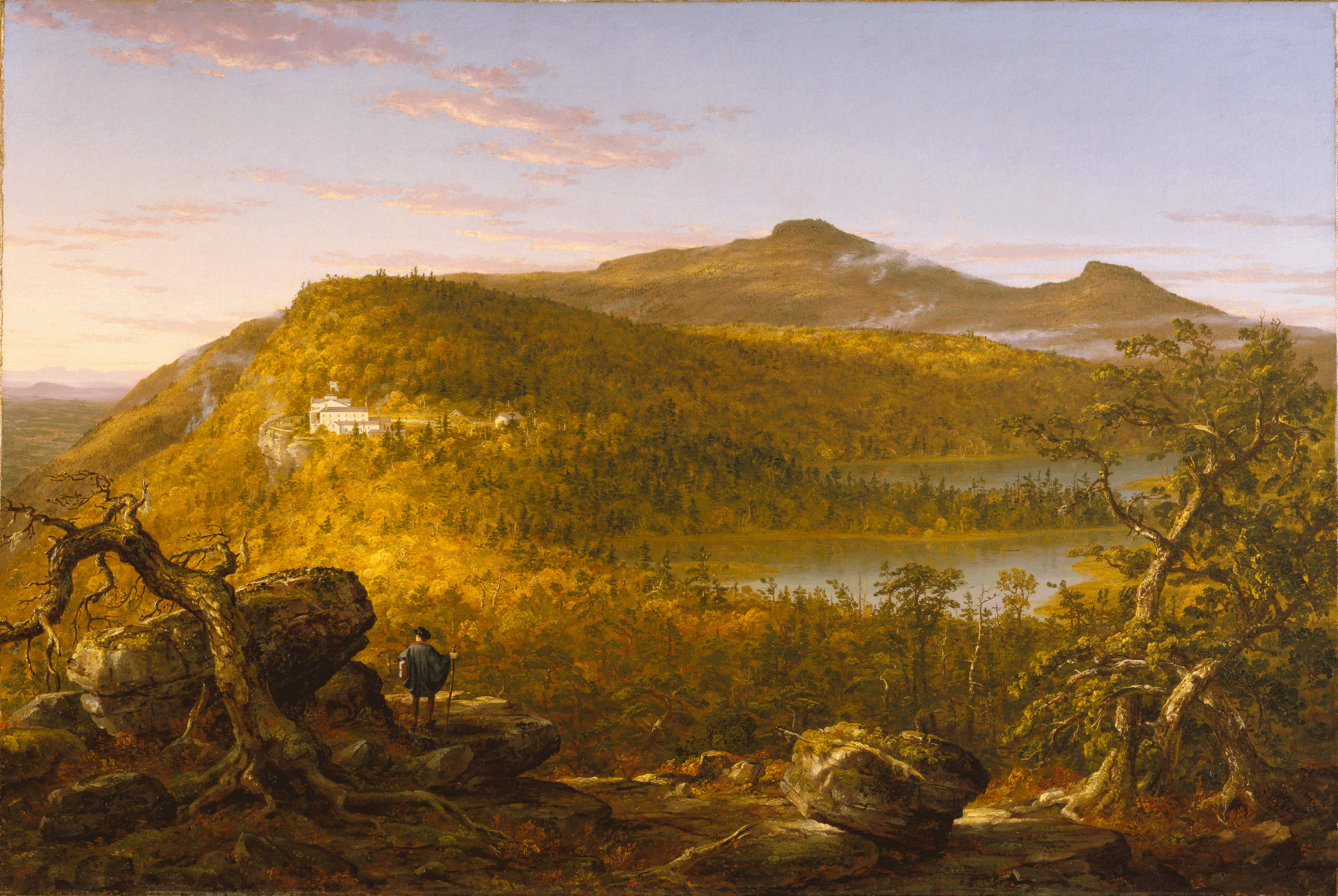A View of the Two Lakes and Mountain House, Catskill Mountains, Morning

Thomas Cole, A View of the Two Lakes and Mountain House, Catskill Mountains, Morning, 1844, oil on canvas, 35 13/16 x 53 7/8 in., Brooklyn Museum, Dick S. Ramsay Fund, 52.16
About
Decode
Compare
Cole's Process
Cole's Words
Locate
About
Originally known as the Pine Orchard Hotel when it opened to the public in 1824, the Catskill Mountain Housewas a premiere destination for Catskill tourists in the early- to mid-nineteenth century. At first only comprised of ten private rooms, the hotel grew to accommodate nearly 200 guests, who often stayed for a few nights to see the surrounding scenery, including Kaaterskill Falls. The most popular feature of the hotel, which was perched on the escarpment of South Mountain in the Catskills, was its spectacular view of the cloud-filled sunrise over the Hudson River, once described as "a boundless ocean."
Cole frequently painted the areas surrounding the Catskill Mountain House, and his journal entries indicate that he must have stayed there himself on a few occasions. Cole was more interested in the mountain's scenic views than in the hotel's entertainments. Describing his impromptu visit to the hotel in July 1835, he complained:
There was much company & as usual in such places few that enjoyed the magnificence that nature spread around them...One party of men was engaged in the intellectual game of ninepins and half a dozen ladies & as many of the other sex were dancing in a long room...What a desecration of the place where nature offers a feast of higher holier enjoyment! Alas that men should thrust their frivolities into the very face of the sublimest regions of the world! 1
Cole's depictions of the rugged landscape of the Catskill Mountainsactually increased tourism to the area. His paintings became the model for many of the engravings included in guidebooks and advertisements for the Catskills during the mid-nineteenth century. In spite of the touristic exploitation of the region, Cole continued to paint scenes of his beloved Catskills until the end of his life. His many variations on this subject brought in much-needed income while he worked on his less-popular allegorical landscapes. 2
Decode
1. Cole depicted the Catskill Mountain House before its remodeling in 1846. The later façade featured a Corinthian colonnade.
2. South Mountain, on which the Catskill Mountain House is located, appears with High Peak and Round Top mountains in the distance. The view is from Sunset Rock on North Mountain. Cole often climbed here in pursuit of picturesque views, calling himself a "Scene-Hunter."
3. Hotel guests often went sailing on North Lake (front) and South Lake (back), although Cole included only this one, simple rowboat in his painting.
4. The figure may be a self-portrait of Cole, suggested by the portfolio of drawings underneath his arm. Viewers can also identify with him, standing on North Mountain and enjoying the expansive vista.
Compare
Sanford R. Gifford, Catskill Mountain House, oil on canvas, 1862, 9 5/16 x 18 ½ in. Private Collection.
Gifford's painting, like Cole's, offers a view from North Mountain with brilliant fall foliage and a human figure on a ledge in the foreground. However, whereas Cole's painting centers the Mountain House in the composition so that it becomes the focus of the image, Gifford pushes it to the right, so that the viewer gets a broad view of the Hudson River Valley below the escarpment. In this way, viewers have access to the majestic prospect that normally only hotel guests could enjoy. 1
Process
By studying the two preparatory works for View of the Two Lakes and Mountain House, we get an idea of the initial stages of Cole's creative process: first, he did an ink sketch to lay out the composition and note specific details of the site; next, he created a study in oils to work out the color scheme. In the finished painting, he integrated the specificity of the drawing with the painterly qualities of the second study. The composition of the final painting is quite similar to the sketches, although Cole pushed the boulder and large tree to the edges of the canvas, allowing space for the viewer to enter the scene. He also replaced the animals in the foreground of the sketches (a snake in the first, a deer in the second) with a depiction of an artist in the final painting. 1
An unfinished painting from the same period as A View of the Two Lakes and Mountain House reveals much about Cole's painting process in the studio. Lake Mohonk is no doubt based on en plein air sketches Cole made during a trip to the Shawangunk Mountains in Ulster County, New York, in August 1846. Laying down a preliminary drawing (penciled lines are still visible under the thin paint), Cole then scumbled in reddish-brown underpaint, making it more or less dense depending on the land masses he planned for the finished work. He then continued filling in the cloud-filled sky and its reflection in the water. (Note how the ground color tints the unfinished portions of the sky.) He also began to detail the uppermost crags and trees, but for some unknown reason, he abandoned the canvas in its half-finished state. This work shows that Cole conceived of the landscape in layers, generally moving from the top down and making adjustments as he went along. His method allowed for many transformations during the painting process, and his landscape views invariably bear the marks of his unique aesthetic sensibilities. 2
Works
1. Thomas Cole, View of the Catskill Mountain House, pen and black ink over pencil on paper, c. 1835, 9 3/8 x 15 ½ in. The Art Museum, Princeton University, Frank Jewett Mather, Jr. Collection.
2. Thomas Cole, Study for A View of the Two Lakes and Mountain House, Catskill Mountains, Morning, oil on canvas, c. 1844, 8 ¾ x 10 ¾ in. Hirschl & Adler Galleries, Inc.
3. Thomas Cole, Lake Mohonk, oil on panel, c. 1846, 20 ¼ × 30 1/8 in. Collection of Questroyal Fine Art, LLC.
4. Thomas Cole, A View of the Two Lakes and Mountain House, Catskill Mountains, Morning, oil on canvas, 1844, 35 13/16 x 53 7/8 in. Brooklyn Museum. Dick S. Ramsay Fund, 52.16.
Words
We strolled down to the small lake which lies about 200 yds. from the house[.] It is diminutive but has beautiful as well as grand features[,] for when there are rich forests & stupendous mountains 'round a lake there must be such.
Leaving the upper lake we pursued our road to [the] lower one, which is much larger & more beautiful[.] I pointed out to Mr. O a view that I once painted, and which picture I believe was the first that was ever painted of that lovely lake that in future time will be the subject for a thousand pencils, except the desolating hand of modern improvement should destroy & deform it... Before us spread the virgin waters which the prow of the sketcher had never curl'd, green woods enfolding them whose venerable masses had never figured in trans-atlantic annuals, and far away the stern blue mountains whose forms were ne'er beheld by Claude or Salvator or been subjected to the canvass by the innumerable dabblers in paint for all time past. The painter of American scenery has indeed privileges superior to any other; all nature is new to Art. No Tivoli's[,] Terni's[,] or Mont Blanc's or Plinlimmons, hackneyed & worn by the daily pencils of hundreds, but virgin forests, lakes, & waterfalls feast his eye with new delights, fill his portfolio with their features of beauty & magnificence and hallowed to his soul because they had been preserved untouched from the time of creation for his heaven-favoured pencil. 1
Find it here.
